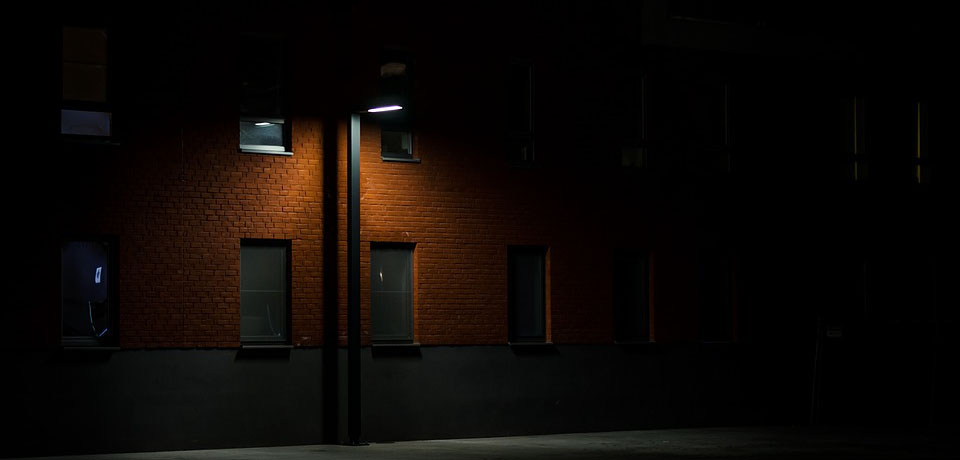
A guide to security lighting for your home or workplace
The nights are beginning to draw in and it’s a good time to make sure your lighting is ready for action over the autumns and winter months.
Lighting is an often overlooked security measure but as well as providing a necessary component for other security elements such as manned patrols or CCTV. However, there are situations where installing lighting badly or in the wrong place might actually help intruders.
This guide explains the main kinds of security lighting and outlines key tasks that will help you make sure you have good, functional lighting that will keep your property and the people within it safe.
In what ways does can security lighting help to prevent crime?
Home office research suggests that security lighting works to prevent crime for the following reasons:
- It can suggest evidence a property is occupied to intruders
- Well positioned lighting can highlight the presence of an alarm or CCTV camera
- Well positioned lighting can also ensure that CCTV footage is clear
Where are the best places to install security lighting?
Permanently on or activated lights would be beneficial:
- By the entrance door . It is helpful to position the light to one side so it lights up a visitor’s face. If the light needs to go above the doorway, try not to make it too high and check that it doesn’t case shadows over the face of anyone you are checking through a chain or spyhole.
- In a side path or alleyway, as long as this area can be seen by neighbours or passers by on the street.
- Above a gate. The light will hopefully deter any intruder trying to climb over it.
- Where you park your cars. This can be helpful in deterring car theft, but make sure you don’t leave valuables, bags etc. in the car.
Places where it may not be ideal to install security lighting
In some places, where there is very little likelihood of neighbours or passers by seeing intruders, a manual switch is the best option. This means you can see if you need to but lighting here is more likely to help an intruder see what they are doing than act as a deterrent. Locations like this include:
- Garden outbuildings or
- Rear doors
- Side and rear gardens
- Very rural and remote premises
What are the different kinds of lighting?
Motion activated security lights
Motion activated security lights become active when the PIR (passive infrared) sensor detects movement. As well as a security feature, it’s also helpful for anyone approaching doors or using paths after dark to see their way without wasting energy on full time light. Good quality security lights can be adjusted so that you determine the range that the light is activated from and how dark it is before it starts working.
Solar Security lights
Solar security lights absorb the energy from the sun during the day by using rechargeable batteries and should then give light for 10-12 hours. As solar technology improves, these are often a cost-effective and eco friendly option.
Timer security lights
Security lights can be programmed to switch on and off at set times. While not the most cost-effective lighting option, these lighting systems are particularly helpful at deterring intruders because unoccupied homes, especially those not displaying lights, are more likely to be burgled. When planning the timing of the lights, think about your normal office or domestic routines and note down when certain lights most often switch on and off for a few days before programming them to operate when the property is empty. Nowadays you can also get timed lights which mimic the effect of a TV which can be effective.
LED and Halogen flood lights
Floodlights are the most common type of outdoor lighting. LED flood lights use lower levels of energy than halogen lights. Both solar and mains options are available.
Motion activated lights
Lights can be activated by movement within certain areas thanks to passive infrared detectors (PIRs). Bear in mind that cheaper non adjustable PIR detectors can result in activations caused by activity occurring in a neighbouring garden, or people walking along the street. They can of course be set off by cats and foxes and other animals too, and it is always a good idea to seek a motion activated light which has a dusk to dawn switch so it only operates during darkness.
Things to consider when choosing the type of lamp and position of lighting:
Make sure lights are positioned correctly
Poorly positioned and unshielded lights can actually mean your neighbours only see the glare of the lights as they look into your property. Ideally, a good security light should send a small area of light onto the ground, with light going downwards, and not spilling onto the neighbouring property or causing glare to anyone looking at the area from a neighbouring property or the street.
Make sure you use the right light bulb wattage — not too bright!
Some lamps are far too bright for their intended use and may in face breach Building Regulations which suggest outdoor lighting of 150W maximum (click here for more information). In addition, very bright lights may be cheap to buy initially but expensive to run. They can also cast shadows which help intruders to hide as they approach or survey a property.
As always choosing the right lights and installing them correctly is key and it is also important to consider all your other security measures, including alarms and doorways when planning your lighting. We’re always happy to offer advice and help. Call us on 01726 65636 or email security@waldons.co.uk for helpful, friendly advice.




